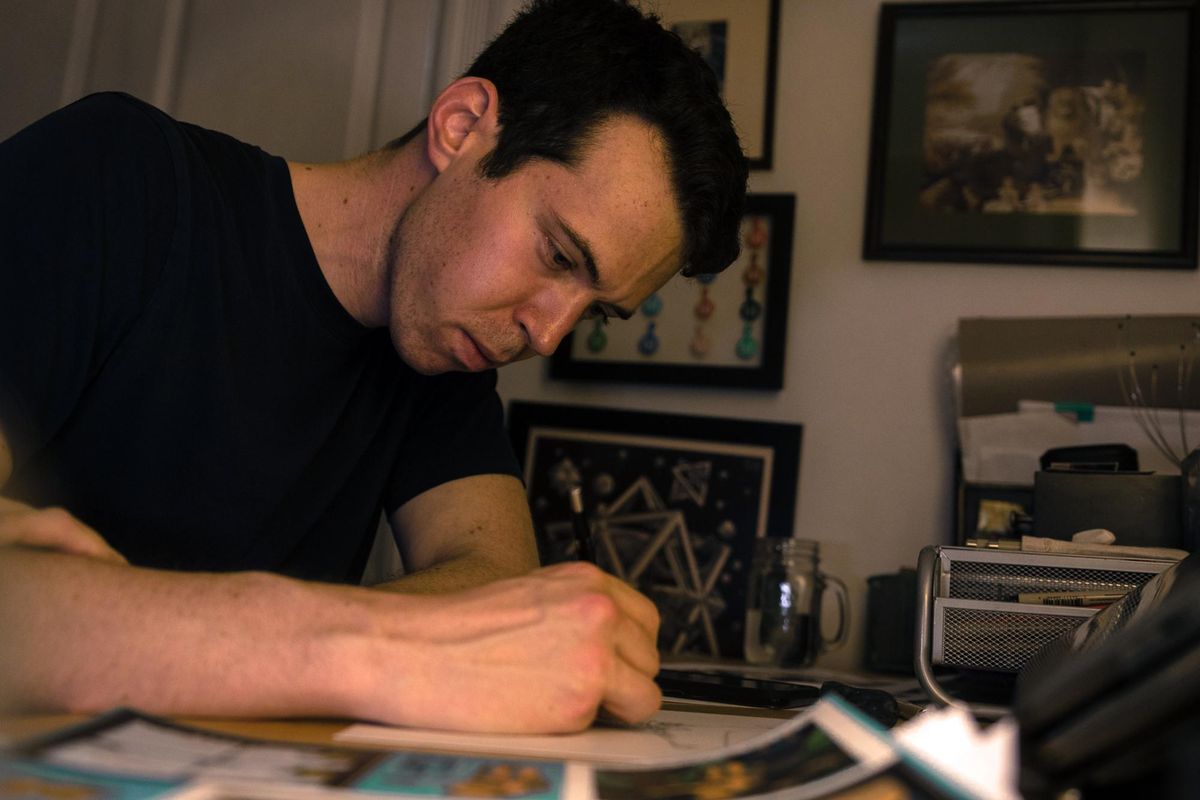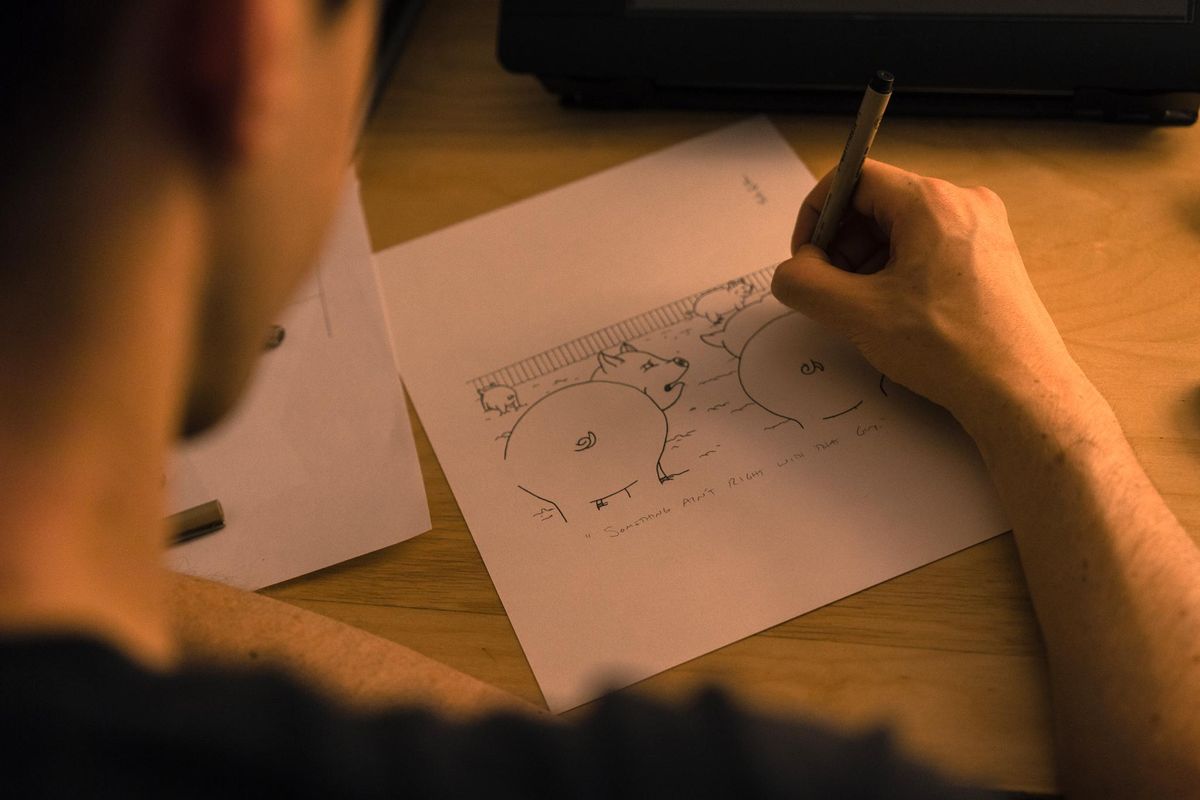Spokane-raised Jody Zellman looks to find his way into his hometown paper’s pages
Jody Zellman, 31, competed with nine other artists during autumn to score a weekly gig as the new cartoonist in The Spokesman-Review. (Shuhei Kinoshita / For The Spokesman-Review)
It’s not a calling. It’s an inevitability.
Illustrate this: It’s 2008 and you’re a sophomore in college at the Columbia University seeking a degree in anthropology and modern Jewish studies. Your student newspaper puts out an all points bulletin for comic strips.
You’re witty and funny, you think. You have pizazz and personality. You’re up-to-date on politics. You get it.
You’re not a great illustrator, at least not yet, but you have an idea – a single panel about Barack Obama and John McCain leading up to the election. They’re shaking hands on Sept. 11, and fighting again on Sept. 12. It’s crudely drawn, but it’s clever. Pizazz.
The newspaper editors like it. They publish it. You’re hooked.
Next thing you know, you have a weekly spot in the paper. Then an internship in the humor and cartoon department of the venerable New Yorker magazine. Finally, a candid conversation with print-comic legend and then-New Yorker cartoon editor Bob Mankoff.
You mention to Mankoff you have a few comics of your own. He asks you to bring them in. Who knows, if they’re good maybe they’ll print them – inevitability.
But he doesn’t print them, so much as tear them to shreds. Figuratively, of course. You are devastated.
Only, you are not you. You are Jody Zellman, a Spokane-born independent cartoonist living in Brooklyn who took Mankoff’s advice to paper: draw better, do your own color, find a voice. Have style. Make it funny.
“After that I really put my head down and worked on my fundamentals,” said Zellman, who this September will celebrate the two-year anniversary of his comic strip “Earth to Planet.” “It’s pretty hard to find people who can give you constructive feedback on comics.”
Zellman, 31, is one of 10 artists Spokesman-Review readers will soon put through a wringer. Beginning today – when the first batch of five comic strips are printed, including Zellman’s – readers will be asked to help select comic strips that could see permanent play in the Spokane funny pages, either daily or in Sunday circulation.

It’s a big change to a section near the back of the paper that’s looked more or less the same for eight years, said Carolyn Lamberson, the S-R’s senior editor for special projects.
“It’s been a long time since we did a survey of comic offerings,” Lamberson said. “We thought it was time to shake things up.”
And like any shake-up, there’s going to be some lost pieces. Online and through snail mail, readers have already been deciding what’s likely to stay, and what’s headed for the chopping block. Those remaining will be joined by any number of the 10 new comic strips.
So far, Lamberson estimates the survey has been completed a few thousand times, though it’s too early to say what’s likely to get the Old Yeller treatment.
Unlike his competition, Zellman is the only artist from Spokane – or Washington, for that matter – and the only artist who’s “independent.” In comic strip speak, that means he’s not syndicated or “printed” anywhere.
It’s a badge of distinction he wears not proudly, but honestly. After all, he has a day job to pay the bills – a position as the director of strategy and operations at ZogSports and ZogCulture, an event-planning and intramural sports league in New York City.
But at night, when he moonlights as a cartoonist, that’s when the real fun begins. For about 20 to 25 hours a week, on weekday evenings, weekend mornings, and as much time as he can find in between, he’s brainstorming, penciling, inking and coloring at least four strips a week.
Those comics eventually make their way to his website and social media pages. On Instagram, he’s amassed an impressive 17,500 followers eager to see his latest drawings, released every couple of days.
“Earth to Planet” is best described as a variety gag strip akin to “The Far Side,” one of Zellman’s main inspirations. Over time, though, a character started to emerge: a green chameleon named Iggy, who much like all of us, would rather camouflage himself and disappear than face some of life’s toughest challenges. Zellman based him on a pet he had growing up at his parents’ house on the South Hill.
Iggy’s joined by his friend and roommate Sol – an affable cockroach or cricket, depending on which day you ask.
“In my mind, when I first started, he was a cricket,” Zellman said.
It’s in these strips that Zellman plays around with recurring gags. Such as the aforementioned Iggy literally fading into the background during awkward encounters. Or the rent-obsessed landlord, spouting nonsense at one point and raising the rent $500 the next.
Or the quest to find the perfect roommate. One strip has Iggy and Sol meeting with a hipster free spirit named Peat, with an “A.” Peat corrects Sol’s spelling after the insect says his name out loud – the fact that Peat knows it’s misspelled is itself a joke only possible in the comic medium.
“Named after the accumulation of decaying matter,” Peat says of his name. “Anyhoo, I brew pumpkin-spiced kombucha.”
“Leave now,” Sol responds.
While drawing and illustration is something Zellman learned postgraduation when he took a few classes at a local school of visual arts, his comedy style is a bit more homegrown. His first public display of such came during a speech he gave at his Ferris High School graduation.
It also probably didn’t hurt that he spent his mornings reading The Spokesman-Review comics as a child with his parents Mary Noble and Hershel Zellman at their home on the South Hill. He was particularly fond of “Calvin and Hobbs,” whose creator, Bill Watterson, he considers an idol.
As a boy, his mom would send him comics at summer camp. And she still does, Jody said.
And even as a kid, Zellman’s elementary school notebooks were covered in doodles, Noble said. Some of them quite auspicious for an 8-year-old.
But compared to where they are today, not even close. For good reason, too.
As his mentor, Mankoff, often says in his seminars and talks, humor should exist in the sweet spot between benign and violation. Meaning, for something to be funny, the audience should think it’s wrong, but also OK. Too much wrong, and it’s not funny. And if it’s completely OK, what’s the joke?
Zellman’s early cartoons – yes, even in his college days – didn’t quite hit the spot. And Mankoff made sure his young apprentice knew it.
“He needed to improve his drawing” said Mankoff, who now runs cartooncollections.com, when reached by phone Tuesday. “He needed to improve his joke. And he needed to do a lot of work, which meant produce a lot of cartoons in order to find out the kind of cartoon he wanted to do. Out of a lot of quantity would come some quality, provided he had some talent. And he did. Clearly.”
Mankoff said that, at the time Zellman came through the building, there were many interns who thought they could make the cut, provided they had a good idea.
But it’s only after producing a lot of work – sometimes producing dozens of drawings a day – that the true winners rise to the top. That takes time, though. And work ethic.
Then there’s finding an audience. On that, Mankoff gives Zellman a satisfactory grade, even if the style and humor still wouldn’t fit within the pages of the New Yorker.
“I always convey this to people: The most important thing to do to make it worthwhile is to do the cartoons that you actually like,” Mankoff said. “If you are the only one who likes them, that’s not a good business to be in. But as long as you get some other people to like them, it’s worthwhile.”
With all the feedback he could hope for, and a full pen of ink, Zellman trudged on. To where he is now: sitting on a literal stockpile of comics, all them waiting for their time in the sun, er, Sunday section.
“Personally, for me, it’s a really important art form,” Zellman said. “Especially today, where attention spans are limited, and you’re vying for people’s time constantly. You have to capture an idea in a square image, and have a rapid-fire communication of those ideas.
“I love that.”

